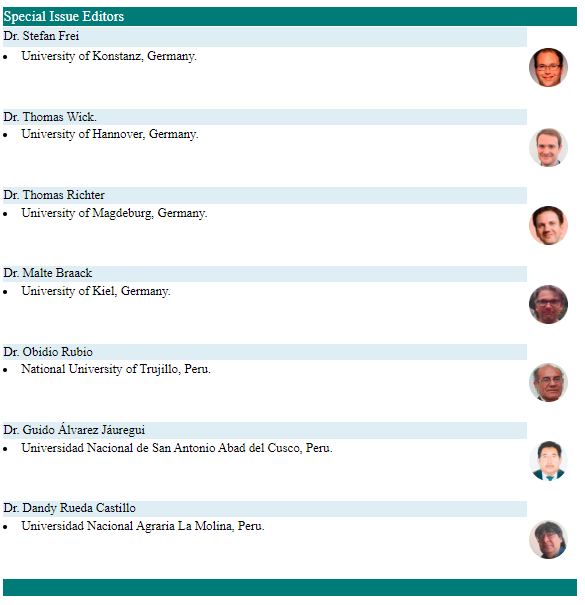Stability of a Leslie-Gower type predator-prey model with a strong Allee effect with delay
DOI:
https://doi.org/10.17268/sel.mat.2022.01.02Keywords:
Allee effect, Leslie-Gower predator-prey model, delay parameter, stability, Hopf bifurcationAbstract
In this paper, a modified Leslie-Gower type predator-prey model introducing in prey population growth a delayed strong Allee effect is studied.
Estabilidad de un modelo depredador-presa tipo Leslie Gower con un efecto Allee fuerte con retardo
The Leslie-Gower model with Allee effect has none, one or two positive equilibrium points but the incorporation of a time delay in the growth rate destabilizes the system, breaking the stability when the delay cross a critical point. The existence of a Hopf bifurcation is studied in detail and the numerical simulations confirm the theoretical results showing the different scenarios.
We present biological interpretations for species prey-predator type.
References
Aziz-Alaoui MA, Daher Okiye M. Boundedness and global stability for a predator-prey model with modified Leslie-Gower and Holling-type II schemes, Applied Mathematics Letters 2003; 16:1069-1075.
Bazykin AD. Nonlinear Dynamics of interacting populations, World Scientific 1998.
Berec L, Angulo E, Courchamp F. Multiple Allee effects and population management, Trends in Ecology and Evolution. 2007; 22:185-191.
Celik C. Hopf bifurcation of a ratio-dependent predator-prey system with time delay, Chaos, Solitons and Fractals. 2009; 42:1474-1484.
Clark CW. Mathematical Bioeconomics: The Mathematics of Management. (2nd ed), John Wiley and Sons Inc. 1990.
Courchamp F, Clutton-Brock T, Grenfell B. Inverse dependence and the Allee effect, Trends in Ecology and Evolution. 1999; 14:405-410.
Courchamp F, Berec L, Gascoigne J. Allee effects in Ecology and Conservation, Oxford University Press 2008.
Das K, Chakraborty M, Chakraborty K, Kar TK. Modelling and analysis of a multiple delayed exploited ecosystem towards coexistence perspective, Nonlinear Dynamics 2014; 78(1):505-523. DOI 10.1007/s11071-014-1457-3.
Freedman HI.Deterministic Mathematical Model in Population Ecology. Marcel Dekker; 1980.
Freedman HI, Rao VSH. The tradeoff between mutual interference and time lag in predator prey models., Bull. Math. Biol. 1983; 45:991-1004.
González-Olivares E, Mena-Lorca J, Rojas-Palma A, Flores JD. Dynamical complexities in the Leslie-Gower predator-prey model as consequences of the Allee effect on prey, Applied Mathematical Modelling. 2011; 35:366-381.
González-Olivares E, Mena-Lorca J, Rojas-Palma A, Flores JD. Erratum to “Dynamical complexities in the Leslie-Gower predator-prey model as consequences of the Allee effect on prey”. [Appl. Math. Modell. (2011) 366-381], Applied Mathematical Modelling. 2012; 36:860-862.
Ho C-P, Lin C-H, Huang H-N. On the Lyapunov functional of the Leslie-Gower predator-prey models with time-delay and Hollings’s functional response, Electronic Journal of Qualitative Theory of Differential Equations. 2012; 35:1-27.
Li Y, Li C. Stability and Hopf bifurcation analysis on a delayed Leslie-Gower predator-prey system incorporating a prey refuge, Appl. Math. and Comp. 2013; 219:4576-4589.
Liermann M, Hilborn R. Depensation: evidence, models and implications, Fish and Fisheries. 2001; 2:33-58.
Hale JK, Lunel SMV. Introduction to functional differential equations (Vol. 99). Springer Science and Business Media. 2013.
Kot M. Elements of Mathematical Ecology, Cambridge University Press 2001.
Kuang Y. Delay differential equations with applications in Populations Dynamics, Academic Press, Inc. 1993.
Kuang Y, Beretta E. Global qualitative analysis of a ratio-dependent predator-prey system, J. Mat. Biol. 1998; 36:389-406.
Kumar P, Raj S. Modelling and analysis of prey-predator model involving predation of mature prey using delay differential equations. Numerical Algebra, Control and Optimization. 2021.
Liu J. Bifurcation analysis in a stage-structured predator-prey model with maturation delay, Int.J. Mat. Biol. 2014, Vol 7(4):(1-17)
May RM. Stability and complexity in model ecosystems (2nd edition), Princeton University Press 2001.
Nindjin AF, Aziz-Alaoui MA, Cadivel M. Analysis of a predator-prey model with modified Leslie-Gower and Holling-type II schemes with time delay, Nonlinear Analysis: RealWorld Applications. 2006; 7:1104-1118.
Pal PJ, Saha T, Sen M, Banerjee M. A delayed predator-prey model with strong Allee effect in prey population growth, Nonlinear Dynamics 2011; 68(1):23-42.
Smith H. An Introduction to Delay Differential Equations with applications to the Life Sciences, Springer 2011.
Stephens PA, Sutherland WJ. Consequences of the Allee effect for behaviour, ecology and conservation. Trends in Ecology and Evolution. 1999; 14:401-405.
Stephens PA, Sutherland WJ, Freckleton RP. What is the Allee effect?, Oikos. 1999; 87:185-190.
Turchin P. Complex population dynamics. A theoretical/empirical synthesis, Monographs in Population Biology 35 Princeton University Press, 2003.
Xua R, Gan Q, Ma Z. Stability and bifurcation analysis on a ratio-dependent predator-prey model with time delay, J. Comput. Appl. Math. 2009; 230:187-203.
Yue Y, Lui H, Wei Y, Ma M, Zhang K. Dynamic study of a Predator Prey Model with Weak Allee Effect and Delay, A. Math. Physics. 2019; 2019:1-15.
Downloads
Published
How to Cite
Issue
Section
License
Copyright (c) 2022 Selecciones Matemáticas

This work is licensed under a Creative Commons Attribution 4.0 International License.
The authors who publish in this journal accept the following conditions:
1. The authors retain the copyright and assign to the journal the right of the first publication, with the work registered with the Creative Commons Attribution License,Atribución 4.0 Internacional (CC BY 4.0) which allows third parties to use what is published whenever they mention the authorship of the work And to the first publication in this magazine.
2. Authors may make other independent and additional contractual arrangements for non-exclusive distribution of the version of the article published in this journal (eg, include it in an institutional repository or publish it in a book) provided they clearly state that The paper was first published in this journal.
3. Authors are encouraged to publish their work on the Internet (for example, on institutional or personal pages) before and during the review and publication process, as it can lead to productive exchanges and to a greater and more rapid dissemination Of the published work.












